Interviewed by Maggie Stevens (17th April 2013) — Audio files:
Read Tom’s story below, or click here for .pdf version.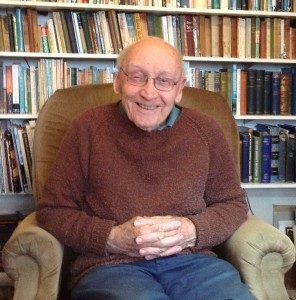
Tom was 14 when war broke out, and clearly remembers hearing the Prime Minister on the radio, making the announcement that war had been declared – 11.00 a.m., on a Sunday he thought [Sun 23rd September 1939].
The family – Tom, his mother and father, and sister, Maud – were all listening to the radio in the kitchen of their house in Tilty (now 1 Church Cottages). Tom said that everyone was expecting the announcement really – following the invasion of Poland. The family lived in Tilty and London, at the time – had a baker’s shop in London, where Tom’s father, brother and eldest sister worked during the week – coming back to Tilty at the weekends.
Tom had been at school – Great Easton school – but had just left, as he was 14 years old – and had started working for the council in Great Dunmow. He carried on working for the council, until he volunteered for the navy in 1942; he said he opted for the navy because of the uniform! All the boys wanted to join the forces, and Tom’s mother was not surprised that he wanted to join up. Tom’s older brother was in a reserved occupation, as a baker, so didn’t join the forces. Tom said that his family – running the bakery through the Blitz – were possibly in more danger than he was.
Tom was 17 when he joined the navy, and was called up a week after his 18th birthday in 1942; liked the uniform once he was entitled to wear it!
[ 01:55 Training, and Invasion of Sicily ]
First ship — destroyer, HMS Eggesford – but before that, in Combined Operations. Tom was at HMS Ganges for preliminary training of about 10 weeks; at Chatham Barracks, waiting for a ship, and there was a notice up asking for volunteer despatch riders. As Tom was crazy on motor cycles – and had one at home – he went to the Drafting Master at Arms who asked: ‘Can you ride a motor bike, boy?’ Tom said he had one at home, and the Master at Arms said: ‘You’ve just volunteered for Combined Operations. Seven days embarkation leave, draw your tropical kit from the stores.’ Seven days later Tom was on a troop ship bound for Egypt, because at that time the Mediterranean was closed to shipping and all the convoys went round the Cape to Cape Town and up the other side of Africa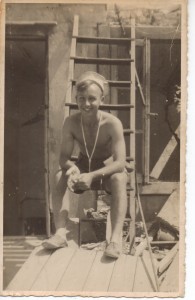 and up to Egypt – a long way round; Tom thought it took a period of about eight weeks. That was Tom’s first sea voyage, and when he arrived in Egypt they were put under canvas in the desert, and trained with the Eighth Army for an invasion. But, of course, then they didn’t know where they were going. After some weeks of training in the desert, they were put into troop ships – in Tom’s case it was the Bergesfjorde, a Norwegian troopship – and they sailed through the Suez Canal. The lads were all predicting different places they might be going – the wags suggested places like Canvey Island. But when the maps were produced, it was in fact Sicily. And that was the first thing they knew about where they were going to invade.
and up to Egypt – a long way round; Tom thought it took a period of about eight weeks. That was Tom’s first sea voyage, and when he arrived in Egypt they were put under canvas in the desert, and trained with the Eighth Army for an invasion. But, of course, then they didn’t know where they were going. After some weeks of training in the desert, they were put into troop ships – in Tom’s case it was the Bergesfjorde, a Norwegian troopship – and they sailed through the Suez Canal. The lads were all predicting different places they might be going – the wags suggested places like Canvey Island. But when the maps were produced, it was in fact Sicily. And that was the first thing they knew about where they were going to invade.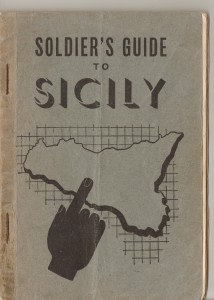
As they came closer to Sicily, the sea became full of ships – there were ships everywhere, because it was a very big invasion force. In fact, as Tom was given to understand, it was the biggest seaborne invasion of the war, based on the number of ships involved.
[ 03:30 Sicily, and HMS Eggesford ]
And so Tom took part in the invasion of Sicily (July 1943). A major snag, from Tom’s point of view, was that when they got ashore there were no motorcycles as the merchant ship carrying all the bikes had been sunk. So they were told to get motorbikes where they could, and went round the town of Syracuse commandeering motor cycles. In Tom’s case, he got hold of a 600 cc Gilera with a red tank – which was an extremely fast motorbike! – and was very happy indeed. Tom took part in taking dispatches forward and back through Syracuse; quite an exciting time. Syracuse was the principle port in those days.
In the wake of the invasion of Sicily, the next step was obviously going to be the invasion of Italy, and Tom asked if there was any chance of him going to sea – as he was an Able Seaman. A destroyer – HMS Eggesford – came into harbour, and there was a vacancy for a member of crew, and so Tom was drafted to a Hunt class destroyer. A Hunt class destroyer had a crew of around 160; it was the smallest destroyer there was at the time – 4 inch guns. Their job was to escort convoys around the coast of Italy, for example, from Taranto up the Adriatic coast to Brindisi or Bari – which was as far as they could go, as the Germans were just beyond Bari. Or they might escort another convey from Naples, or Sorrento (where everybody goes on holiday now) on the other side of Italy. These were exciting times, as the Germans were in close range – the other side – in Yugoslavia and Albania, the countries over there. So they were well within range of the Germans, plus they had bases there with E-boats [ in German – Schnellboot, or S-Boat, meaning ‘fast boat’ ], and the E-boats were constantly attacking the convoys. So the destroyers had quite a lively time of it. The Eggesford could do 30 knots, but she was not one of the big fleet destroyers; as above, the smallest size in the fleet.
[ 05:30 Cyril Hitchin ]
Tom wasn’t injured in the war – went through the war without a scratch – but he lost friends during the war, both in Sicily, and later when he served aboard an aircraft carrier. Tom remembers a local man who died during the war, Cyril Hitchin, from Duton Hill. Tom and Cyril were exactly the same age, and they sat next to each other at the village school; sadly Cyril was killed while serving in the army in Italy – in the Monte Cassino area, Tom believes.
[ 06:05 Leave – periods of home-leave – and the end of the war ]
Tom was drafted home from the destroyer in 1944, and had leave at home in Tilty. Eventually joined an aircraft carrier – qualified as a torpedo-man – and was drafted to an aircraft carrier, HMS Vengeance (a Light Fleet Carrier), bound for the Pacific. They sailed through the Mediterranean down to Ceylon, Colombo; operated there for a while – then they sailed to join the British Pacific Fleet – Sydney being the main base.
They operated then from the Admiralty Islands, until they dropped the bomb – the atomic bomb – on Japan, and the war suddenly ended. 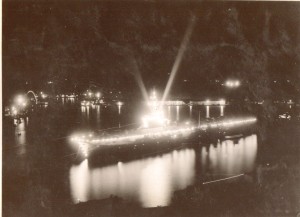 They were then given sailing orders to go to Hong Kong with other ships to take the surrender from the Japanese. They stayed there for a period of about three months, swinging round the buoy, waiting for the army to come up to take over. The war having ended, it was a marvellous time really, Tom said; they all thoroughly enjoyed their stay there. The only time they put to sea was if there was bad weather, as you couldn’t risk the ship breaking its cables – going ashore – so, although it sounds odd, they would go to sea if there was a typhoon or something about!
They were then given sailing orders to go to Hong Kong with other ships to take the surrender from the Japanese. They stayed there for a period of about three months, swinging round the buoy, waiting for the army to come up to take over. The war having ended, it was a marvellous time really, Tom said; they all thoroughly enjoyed their stay there. The only time they put to sea was if there was bad weather, as you couldn’t risk the ship breaking its cables – going ashore – so, although it sounds odd, they would go to sea if there was a typhoon or something about!
Tom Cowell — Session 2 (of 3) — 17th April 2013
Interviewed by Maggie Stevens (recording approx. 10 minutes in duration)
[ Other local people who joined the Forces ]
Tom spoke of another friend who joined the Navy, a Dunmow man, who had a very different career. He was a colleague of Tom’s, at the Council Offices where they both worked, and joined the Navy at much the same time as Tom did in 1942. He was a signalman, and was drafted to a landing-craft rocket – a landing craft with rockets that was used at times of invasion. The only foreign service he had was across to Holland, where they took part in the bombardment during the invasion there. That was as far as he went; he was at one time stationed at Braintree, where there was a small Royal Naval signal section, and he would go on leave to Dunmow on his bicycle. Very different experience from Tom’s wartime travels.
[ 01:07 Despite the war, which was most enjoyable part of travel experiences? ] Tom’s first foreign port was Cape Town; Tom had a few days there when he was on a troopship going to Egypt. They hadn’t tasted bananas since the war started, and everybody rushed ashore and bought bunches of bananas and brought them back on board. The people were very kind there, and welcoming; invited them into their homes. Tom had good memories of just those two or three days in Cape Town.
Then the voyage continued up to Egypt, which was a complete contrast, where they lived under canvas in the desert.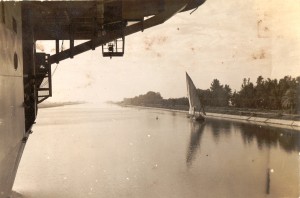
[ 01:30 Other interests – ballroom dancing ]
Before the war, when he was about seventeen, Tom had taken lessons; his brother had been a keen ballroom dancer, and it was regarded as a very useful social skill to acquire, and Tom at least knew how to dance. When he was serving on HMS Vengeance – the aircraft carrier – Tom had a friend who was also a keen dancer, and when they went ashore, where the average sailor headed straight for the nearest boozer – they headed for the nearest Dance Hall. They had much the better time of it, as British sailors were very popular with the local girls. They went to dances in a whole range of places: Gibraltar, Malta, Egypt (Alexandria), Colombo, and Sydney, where there were great dance halls.
[ 02:30 Food on board ship ]
Quality varied considerably. On the destroyer, the first ship Tom was on, they had what was known as ‘Canteen Messing’, where the sailors on the Mess Deck prepared the meals, then took them to the Galley where the cook cooked them. There was a recipe book, a small book that they were all issued with when they joined the Navy, on how to prepare food on board. You prepared it on the Mess Deck, when you were Cook of the Mess, the galley cooked it for you, then you brought it back. The old sailors became very good at making what they called ‘duff’ – puddings – whereas the Ordinary Seamen just put rice in a dish and took it up to the galley to be heated up. But the old sailors were pretty good cooks. On the bigger ships, you merely went to the galley and collected the food – which was already cooked and prepared – and took it back to the Mess Deck; two different systems.
Tom was asked if he’d had any particular favourite foods on board ship. He thought that any sort of stew (or ‘mess pot’ as it was called) was popular – if it had the right meat and vegetables. They would have access to fresh vegetables in port, but mostly tinned fish – herrings and the like. Tom said that they didn’t eat too badly, and were possibly better off than some of the other services for food.
[ Other useful skills ]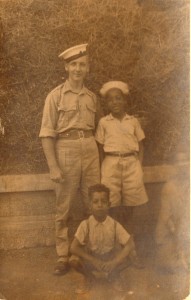
Everybody had to do their own washing on board ship; you washed your clothes in a bucket, with soap powder from the canteen, and hung it up on the Mess Deck to dry. You would learn very early not to let things get too dirty, Tom said; it was better to wash them quickly – you soon learned how to do it. Most sailors kept themselves very clean and tidy; always looked neat when you saw them ashore – very unusual to find a sailor in dirty clothes.
[ 04:10 Leave – how often did Tom come home? ]
Tom didn’t come home from his first overseas posting for a period of about 18 months – from the time of going abroad, to the time of coming back. Then again, with the second posting to the Pacific – which took him up to when the war ended – Tom didn’t get much home leave; just one little period between ships, when he was back in England. Other than that he didn’t have home leave.
Everybody was having home-coming parties when the war ended, but Tom’s father asked him whether he would like a party, or a new motorcycle. ‘What a choice,’ Tom said – only one answer. And his father bought him a new Triumph twin; ‘marvellous it was!’.
[ Post-war ]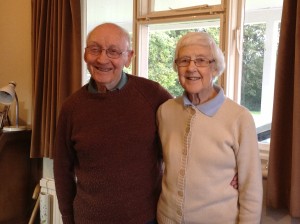
Tom got married – to Beryl – in 1948; they met at a dance in Dunmow in 1946. Tom said that his girlfriends had to have particular qualities: they had to be willing to ride on the pillion of a motorcycle – and not every girl would; they had to be very good dancers; and they had to like sport. Beryl ticked all of these boxes, and they were married within 18 months of meeting each other; still married – 64 years later [at time of interview/ April 2013].
[ Boxing]
Tom boxed as a young man, before he joined the Navy, and belonged to a boxing club in Felstead. He boxed once at Foakes Hall, in Dunmow; still has a newspaper cutting about when he won a three-round bout on points. Boxed whilst in the Navy too; on the Ganges (training ship). And on the troop ship – going down towards Freetown (a very hot part of the world), they put a ring up on the well deck and asked if there were any boxers in the crew, as they wanted to put on a boxing tournament. The Officer in charge of their small naval unit – as they were merely passengers on the troop ship – asked if anyone could box, and Tom said that he belonged to a boxing club at home. ‘OK,’ the Officer said, ‘you’re boxing then – the lightweight class.’ Tom went on to win the lightweight class. He first fought an Army corporal, a little fat chap who really had no idea of boxing – swung his arms like a windmill, so it was a fairly comfortable win. Then he fought a petty officer who was a reasonable boxer – a southpaw – and Tom managed to beat him on points. As winner of the lightweight class, Tom was given a canteen voucher to spend at the canteen – thirty shillings – and he spent it all on tinned fruit.
Tom boxed again on the way up the other side of Africa, but lost on points to someone who was clearly a much better class boxer. The trouble with boxing in the forces, Tom said, is that you didn’t know how good the opposition was; when you’re an amateur boxer in civilian life you usually get put in against somebody of your own standard. This chap that Tom fought had a broken nose and a cauliflower ear and he looked as if he was an old pro at fighting, which he clearly was – particularly as he came in to cries from his supporters of “Up the Razor!”. At this point Tom decided that Forces’ boxing was not really a good idea; plus you couldn’t train very well on board a ship. So, apart from sparring with people from time to time – for exercise – Tom didn’t box again during the war.
[ 07:20 Navy pay ]
Tom was paid three shillings a day, but they were advised to make a payment home to their mothers, and most of them did. Tom paid out seven shillings a week – allocated to his mother – from his pay. When the war ended, Tom’s mother gave him a Post Office Savings Book with all the money he’d sent home to them while he was away.
So Tom came home to a brand new motorcycle, money in the bank, and the girlfriend who became his wife!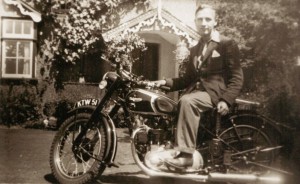
Tom also went back to work at the Council Offices. There had been an agreement, before he went off to serve in the Navy, that there would be a job to come back to, and Tom resumed work with them in 1946. The war ended in August 1945, but it was a while before Tom could come home.
[ Friends from the Navy ]
Tom made many good friends while serving in the Navy. Don was the friend who would attend the dance halls with Tom, and he came from a little village near Huntingdon – a similar background to Tom’s. They served together until Tom came back home from Australia. They were given the opportunity to be de-mobilised in Australia, if they wished, rather than returning to England. Tom wanted to go home to his mother, father and family, but Don decided to stay out there, and settled in Australia. They 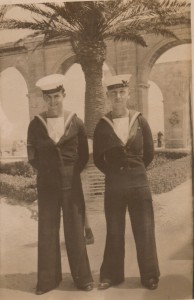 kept in touch across the years, and Tom and Beryl had three wonderful holidays visiting Don and his wife in Queensland – where Don retired to, after working in New South Wales for years. He bought a ‘small plot’ of 60 acres of land, and built a ranch-type bungalow there, in a lovely area, near the Sunshine Coast. Like Tom, Don was a keen sportsman – belonged to the Yumundi Tennis Club – and they played tennis together during their holidays in Queensland; sadly Don died of cancer some years ago.
kept in touch across the years, and Tom and Beryl had three wonderful holidays visiting Don and his wife in Queensland – where Don retired to, after working in New South Wales for years. He bought a ‘small plot’ of 60 acres of land, and built a ranch-type bungalow there, in a lovely area, near the Sunshine Coast. Like Tom, Don was a keen sportsman – belonged to the Yumundi Tennis Club – and they played tennis together during their holidays in Queensland; sadly Don died of cancer some years ago.
[ 09:40 Other friends ]
Tom has met up with some other shipmates after the war. In later years he got in touch with Stan Halford, from HMS Eggesford. Stan – a master saddler by profession, with his own business – lives in Lincolnshire, and is the same age as Tom (now in his late eighties). About ten years ago, Stan put an advert in Navy News asking that if any old shipmates wanted to get meet up, they should get in touch and he would arrange a meeting. Four of them got together, in Lincolnshire, and they have had several enjoyable reunions since – although two have recently died.
There was also a chap called Snell – who lived in Clacton, and was a retired Police Officer; he served on the Vengeance with Tom. During the war, they were leaning over the guard-rail one day, talking – and he asked where Tom came from. Tom said Essex – Dunmow – and Snell said that his father was a Police Sergeant in Dunmow, and he’d lived there for years. So, consequently they would talk from time to time on board the ship. After the war he got in touch with Tom, and Tom and Beryl went down to visit him several times. Sadly, he also died a few years ago – but they had been able to meet again and talk about the old days on several occasions. Tom said he wasn’t somebody you’d normally make friends with aboard ship, as he was a Ship’s Policeman – known as ‘a crusher’ in the Navy!
The Vengeance had reunions, and Tom went to two of these early on – but Tom never met anyone he knew, as most of them had joined the ship after the war. The Vengeance had quite a long history, because it was sold to Argentina eventually; she wasn’t scrapped until she’d given something like fifty years of service. Vengeance went first of all to the Australian Navy after the war, and then ended up in Argentina.
Tom still takes the Naval News, a monthly publication, which he then hands on to other sailors. One of these is Maurice Saitch, who is from Great Easton (and now lives in Dunmow) who also served on destroyers during the war.
Tom also talked through his campaign medals – see below, from left to right.
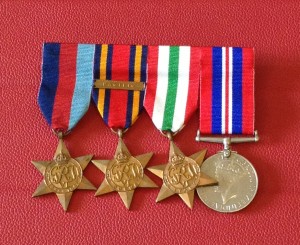
- The 1939-45 Star – awarded for operational service between 3 September 1939 and 2 September 1945.
- The Burma Star, with the Pacific Rose – because of service in the two campaigns.
- The Italy Star – awarded for operational service in Italy, or in Sicily between 11 June and 17 August 1943.
- The War Medal – for serving in the Second World War.
Campaign medals are awarded for having served in a particular area, and for a qualifying period of time. More information about Stars and Medals awarded for Service in the 1939 to 1945 War may be found here:
https://www.gov.uk/guidance/medals-campaigns-descriptions-and-eligibility#world-war-2-medals
Tom wears his medals only on Armistice Day.
Updated 9th January 2018
[Links restored 6 February 2024]
